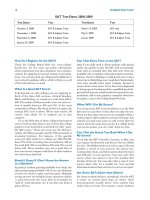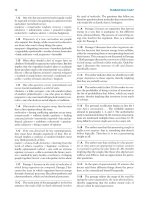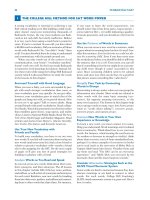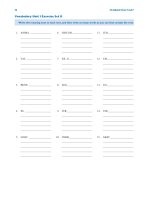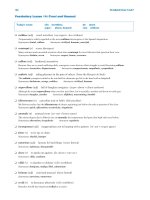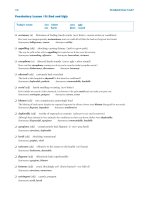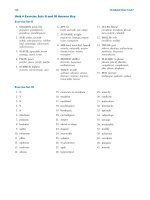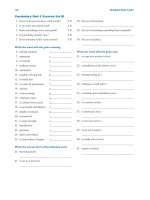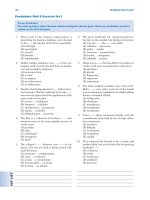Sat - MC Grawhill part 73 doc
Bạn đang xem bản rút gọn của tài liệu. Xem và tải ngay bản đầy đủ của tài liệu tại đây (224.19 KB, 10 trang )
710 MCGRAW-HILL’S SAT
2 2 222 2
GO ON TO THE NEXT PAGE
6. If , what is the value of x?
(A) 3
(B) 9
(C) 27
(D) 36
(E) 81
7. Chris buys a chocolate bar and a pack of gum
for $1.75. If the chocolate bar costs $.25 more
than the pack of gum, how much does the pack
of gum cost?
(A) $.25
(B) $.50
(C) $.75
(D) $1.00
(E) $1.50
8. 40% of 80 is what percent of 96?
(A) 20%
(B) 30%
(C) 33
1
⁄3%
(D) 50%
(E) 66
2
⁄3%
9. If l, m, and n are positive integers greater than
1, lm = 21, and mn = 39, then which of the fol-
lowing must be true?
(A) n > l > m
(B) m > n > l
(C) m > l > n
(D) l > n > m
(E) n > m > l
3720x −=
Note: Figure not drawn to scale.
3. In the figure above, lines l, m, and n intersect
in a single point. What is the value of w + x?
(A) 40
(B) 70
(C) 90
(D) 130
(E) 140
4. Let the function g be defined by the equation
g(x) = 3x + 4. What is the value of g(5)?
(A) 8
(B) 11
(C) 15
(D) 19
(E) 23
5. If x > y, which of the following equations ex-
presses the fact that when the difference be-
tween x and y is multiplied by their sum, the
product is 18?
(A) (x − y)
2
= 18
(B) (x + y)
2
= 18
(C) (x − y) ÷ (x + y) = 18
(D) x
2
− y
2
= 18
(E) x
2
+ y
2
= 18
m
l
n
w°
x°
50°
13. The population of Boomtown doubles every 18
months. In January of 2000, its population was
exactly 12,000. At this rate, approximately when
should the population reach 96,000?
(A) January 2003
(B) July 2004
(C) January 2006
(D) July 2007
(E) January 2012
14. In how many different ways can five students
of different heights be arranged in a line if the
tallest student cannot be on either end?
(A) 24
(B) 25
(C) 72
(D) 96
(E) 120
Note: Figure not drawn to scale.
15. In the figure above, a > 90 and b = c + 3. If a, b,
and c are all integers, what is the greatest pos-
sible value of b?
(A) 43
(B) 46
(C) 60
(D) 86
(E) 89
ANNUAL PROFITS FOR ABC COMPANY
(IN THOUSANDS OF DOLLARS)
10. According to the graph above, ABC Company
showed the greatest change in profits between
which 2 years?
(A) 1996 and 1997
(B) 1997 and 1998
(C) 1998 and 1999
(D) 1999 and 2000
(E) 2000 and 2001
11. In a 9th-grade class, 12 students play soccer, 7
students play tennis, and 9 students play
lacrosse. If 4 students play exactly two of the
three sports and all other students play only
one, how many students are in the class?
(A) 28
(B) 24
(C) 20
(D) 18
(E) 16
12. The point (14, 14) is the center of a circle, and
(2, 9) is a point on the circle. What is the length
of the diameter of the circle?
(A) 24
(B) 26
(C) 50
(D) 144π
(E) 169π
CHAPTER 16 / PRACTICE TEST 3 711
2 2 222 2
GO ON TO THE NEXT PAGE
1996
1997
1998
1999
2000
2001
400
300
200
100
0
–100
–200
b°
a°
c°
712 MCGRAW-HILL’S SAT
2 2 222 2
16. In the figure above, ΔACF is equilateral, with
sides of length 4. If B, D, and E are the mid-
points of their respective sides, what is the
sum of the areas of the shaded regions?
(A) (B) (C)
(D) (E)
17. Given the graph of y = f(x) above, which of the
following sets represents all values of x for
which f(x) ≥ 1?
(A) all real numbers
(B) x ≥ 1
(C) −5 ≤ x ≤−1; 1 ≤ x ≤ 5
(D) −4 ≤ x ≤−2; 2 ≤ x ≤ 4
(E) x ≤−4; x ≥ 4
63
43
42
33
32
X: {2, 4, 6, 8, 10}
Y: {1, 3, 5, 7, 9}
18. If a is a number chosen randomly from set
X and b is a number chosen randomly from set
Y, what is the probability that ab is greater
than 20 but less than 50?
(A) (B) (C)
(D) (E)
19. If w
a
× w
5
= w
15
and (w
4
)
b
= w
12
, what is the
value of a + b?
(A) 6
(B) 7
(C) 11
(D) 12
(E) 13
18
25
3
5
7
25
6
5
1
5
A
B
C
D
F
E
x
y
246
2
4
6
-2
-2
-4
GO ON TO THE NEXT PAGE
CHAPTER 16 / PRACTICE TEST 3 713
2 2 222 2
(B)
(C) (D)
(E)
(A)
x
y
O
123456
1
2
3
4
5
6
x
y
123456
1
2
3
4
5
6
x
y
O
123456
1
2
3
4
5
6
x
y
O
123456
1
2
3
4
5
6
78
x
y
O
123456
1
2
3
4
5
6
78
STOP
If you finish before time is called, you may
check your work on this section only. Do not
turn to any other section of the test.
20. Given the graph of y = f(x) above, which of the
following represents the graph of y = f(x − 2)?
x
y
O
123456
1
2
3
4
5
6
714 MCGRAW-HILL’S SAT
3 3 333 3
GO ON TO THE NEXT PAGE
3. My father is so that he will never even
consider another person’s viewpoint to be
valid if it is different from his own.
(A) pragmatic (B) dogmatic (C) phlegmatic
(D) cordial (E) curt
4. J. K. Rowling’s Harry Potter series is a collec-
tion of works that are for children but
are still to adults.
(A) penned . . prosaic
(B) employed . . morose
(C) censored . . incongruous
(D) designed . . tedious
(E) authored . . engaging
5. Julia approaches her homework assignments
in such way that it is very difficult to be-
lieve that she is at the top of her class.
(A) an adept (B) a diligent (C) a fanatical
(D) an extroverted (E) a laggardly
6. The President was such a orator that his
opponents were always supremely cautious
about agreeing to debate him.
(A) redoubtable (B) staid (C) magnanimous
(D) weak (E) stoic
7. The newest clothing line revealed at the show
was an eclectic mix that ranged from the mod-
est and unadorned to the and garish.
(A) austere (B) prophetic (C) cordial
(D) ostentatious (E) solitary
1. Although he purchased his computer only 10
months ago, rapid improvements in technol-
ogy have left Raúl with machine.
(A) an obsolete (B) an adjunct
(C) a novel (D) an automated
(E) an elusive
2. Only if the number of applicants continues
to can the admissions committee justify of-
fering more scholarships in order to increase the
number of applications.
(A) mushroom (B) expand (C) plummet
(D) satiate (E) burgeon
SECTION 3
Time—25 minutes
24 questions
Turn to Section 3 of your answer sheet to answer the questions in this section.
Directions: For each question in this section, select the best answer from among the choices given and
fill in the corresponding circle on the answer sheet.
Each sentence below has one or two blanks,
each blank indicating that something has been
omitted. Beneath the sentence are five words
or sets of words labeled A through E. Choose
the word or set of words that, when inserted
in the sentence, best
fits the meaning of the
sentence as a whole.
EXAMPLE:
Rather than accepting the theory unquestion-
ingly, Deborah regarded it with
.
(A) mirth
(B) sadness
(C) responsibility
(D) ignorance
(E) skepticism
A
C D
E
B
8. Neil Campbell’s textbook Biology is and
yet ; it includes all of the essential infor-
mation without ever being verbose.
(A) compendious . . circumlocutory
(B) reprehensible . . terse
(C) comprehensive . . concise
(D) praiseworthy . . grandiloquent
(E) painstaking . . redundant
The people of the world, save the majority
of our own citizens, are growing to appreciate
the difference between America and the
United States. America is the heart and mind
of the world. It is an ideal to which all free-
thinking men and women aspire. It is the
spirit of hope, freedom, vision and creativity.
But the United States, at least since the turn of
the century, has become something different.
It constantly grasps at the cloak of America,
but this cloak fits our current leaders quite
poorly. Our leaders have become dominated
by fear and its value as a political tool. They
speak incessantly of freedom but revel in
repression. They speak of a “culture of life”
but revel in the culture of siege and war.
The hope, freedom, vision and creativity of
America have slipped through their fingers,
and they have little hope of recapturing it.
In America, that task is left to the people.
9. The word “unrivaled” in line 5 most nearly
means
(A) without enemies
(B) supremely abundant
(C) militarily superior
(D) unimaginable
(E) highly intelligent
10. Which of the following best describes the con-
trast between the “people” (line 9) as charac-
terized in Passage 1 and the “citizens” (line 20)
as characterized in Passage 2?
(A) the “people” are ignorant, while the
“citizens” are well educated
(B) the “people” lack fortitude, while the
“citizens” are courageous
(C) the “people” are worldly, while the
“citizens” are parochial
(D) the “people” are proud of their leaders,
while the “citizens” are not
(E) the “people” lack unity, while the
“citizens” lack awareness
CHAPTER 16 / PRACTICE TEST 3 715
3 3 333 3
GO ON TO THE NEXT PAGE
Line
5
10
15
20
25
30
35
The passages below are followed by questions
based on their content; questions following a
pair of related passages may also be based on
the relationship between the paired passages.
Answer the questions on the basis of what is
stated
or implied in the passage and in any in-
troductory material that may be provided.
Questions 9–12 are based on the following passages.
PASSAGE 1
The following is from President Bill Clinton’s
first inaugural address.
Today, a generation raised in the shadows of
the Cold War assumes new responsibilities in a
world warmed by the sunshine of freedom, but
threatened still by ancient hatreds and new
plagues. Raised in unrivaled prosperity, we
inherit an economy that is still the world’s
strongest, but is weakened by business failures,
stagnant wages, increasing inequality, and
deep divisions among our own people. When
George Washington first took the oath I have
just sworn to uphold, news traveled slowly
across the land by horseback, and across the
ocean by boat. Now the sights and sounds of
this ceremony are broadcast instantaneously to
billions around the world. Communications
and commerce are global. Investment is mo-
bile. Technology is almost magical, and ambi-
tion for a better life is now universal.
PASSAGE 2
The following is a commentary on America writ-
ten in 2005 by an American writer.
716 MCGRAW-HILL’S SAT
Questions 13–19 are based on the following passage.
The following passage is adapted from a short story
published by a Russian author in the late 1970s.
What is all this? he thought, terrified. And
yet . . . do I love her, or don’t I? That is the
question!
But she, now that the most important and
difficult thing had at last been said, breathed
lightly and freely. She, too, stood up and, look-
ing straight into Ognev Alexeyich’s face, began
to talk quickly, irrepressibly and ardently.
Just as a man who is suddenly overwhelmed
by terror cannot afterwards remember the
exact order of sounds accompanying the cata-
strophe which stuns him, Ognev could not
remember Vera’s words and phrases. His mem-
ory retained only the substance of her speech
itself and the sensation her speech produced in
him. He remembered her voice, as though it were
choked and slightly hoarse from excitement,
3 3 333 3
GO ON TO THE NEXT PAGE
11. Passage 1 makes all of the following claims
about the state of society EXCEPT that
(A) an increasing number of people are
happy with their lives
(B) information is disseminated more
rapidly than in the past
(C) the current economy is strong
(D) social inequities are deepening
(E) workers’ incomes are not increasing
12. Unlike the author of Passage 1, the author of
Passage 2 does which of the following?
(A) contrasts an ideal with a reality
(B) explains a study
(C) compares the past with the present
(D) describes an injustice
(E) acknowledges a responsibility
and the extraordinary music and passion of
her intonation. Crying, laughing, the tears
glittering on her eyelashes, she was telling him
that even from the first days of their acquain-
tance she had been struck by his originality, his
intellect, his kind intelligent eyes, with the aims
and objects of his life; that she had fallen pas-
sionately, madly and deeply in love with him;
that whenever she had happened to come into
the house from the garden that summer and
had seen his coat in the vestibule or heard his
voice in the distance, her heart had felt a cold
thrill of delight, a foretaste of happiness; that
even the silliest jokes made her laugh help-
lessly, and in each figure of his copybook she
could see something extraordinarily clever and
grandiose; that his knotted walking stick
seemed to her more beautiful than the trees.
The forest and the wisps of fog and the
black ditches alongside the road seemed to
fall silent, listening to her, but something
bad and strange was taking place in Ognev’s
heart. . . . Vera was enchantingly beautiful as
she told him of her love, she spoke with elo-
quence and passion, but much as he wanted
to, he could feel no joy, no fundamental hap-
piness, but only compassion for Vera, and
pain and regret that a good human being
should be suffering because of him. The Lord
only knows whether it was his bookish mind
that now began to speak, or whether he was
affected by that irresistible habit of objectivity
which so often prevents people from living,
but Vera’s raptures and suffering seemed to
him only cloying and trivial. At the same time
he was outraged with himself and something
whispered to him that what he was now see-
ing and hearing was, from the point of view of
human nature and his personal happiness,
more important than any statistics, books or
philosophical truths . . . And he was annoyed
and blamed himself even though he himself
did not understand why he was to blame.
Line
5
10
15
20
25
30
35
40
45
50
55
60
13. Which of the following best describes the char-
acterization of the man and the woman in the
first two paragraphs?
(A) He is confused, while she is passionate.
(B) He is angry, while she is jocular.
(C) He is stoic, while she is serene.
(D) He is ambivalent, while she is anxious.
(E) He is disdainful, while she is whimsical.
14. The author suggests that one “who is suddenly
overwhelmed by terror” (lines 9–10) is temporarily
(A) vindictive
(B) defensive
(C) cautious
(D) disoriented
(E) resentful
15. The description of “the catastrophe” (lines
11–12) serves primarily to suggest that
(A) the couple has endured a terrible
accident
(B) Ognev is devastated by Vera’s harsh
words
(C) Ognev is deeply troubled by Vera’s pas-
sionate expression of love
(D) Ognev holds Vera responsible for a crime
(E) Vera has told Ognev a horrible secret
16. In line 24, “objects” most nearly means
(A) possessions
(B) facts
(C) decorations
(D) goals
(E) complaints
17. The passage suggests that the “bad and
strange” (line 39) thing that was taking place
in Ognev’s heart was his
(A) eagerness
(B) sadism
(C) jealousy
(D) hatred
(E) disaffection
18. In lines 57–58, “statistics, books or philosoph-
ical truths” are mentioned as examples of
things that
(A) Vera does not understand
(B) Ognev and Vera share reluctantly
(C) Ognev abandoned long ago
(D) Vera loves passionately
(E) Ognev inexplicably values more highly
than passion
19. The primary function of the final paragraph is
to show Ognev’s
(A) struggle to understand his own feelings
(B) anger about Vera’s misrepresentation of
her feelings
(C) frustration with the voices in his head
(D) outrage with his inability to understand
a philosophical concept
(E) appreciation of Vera’s beauty
CHAPTER 16 / PRACTICE TEST 3 717
3 3 333 3
GO ON TO THE NEXT PAGE
GO ON TO THE NEXT PAGE
718 MCGRAW-HILL’S SAT
3 3 333 3
Questions 20–24 are based on the following passage.
The following is part of an introduction to the
publication of a speech delivered by President
Lyndon B. Johnson in the 1960s.
“Somehow you never forget what poverty
and hatred can do when you see its scars on
the hopeful face of a young child.” So spoke
President Lyndon B. Johnson in the course of
one of the most deeply felt, and deeply mov-
ing, addresses ever delivered by an American
president. The date was March 15th, 1965; the
occasion was an extraordinary joint session at
night of the Senate and the House of Repre-
sentatives, televised across the nation. It was
the “time of Selma”—only a few days after the
historic mass demonstration in support of
voter registration in Alabama, in which many
of the peaceful marchers were physically at-
tacked and one of them, a white clergyman
from the north, was killed. The nation itself
was a shocked witness, via television, of much
of that unforgettable scene: the long rows of
marchers, a cross section of African Americans
and whites, Californians and New Yorkers,
resolutely striding, smiling, singing to hide
their exhaustion, trying not to see the hate-
twisted faces and shouting menace of the side-
walk crowd, trying not to fear the armored
troopers and police with their notorious sup-
porting artillery of dogs, clubs, and cattle
prods.
This was the moment chosen by the Presi-
dent, himself a Southerner with a reputation
for compromise, to bear witness before the
nation, and to call upon his former associates
of Congress to stand up and be counted with
him—more specifically, to take action on a
bill which would correct the conspicuous
weakness of the 1964 Civil Rights Bill, its fail-
ure to protect the right of African Americans
to vote “when local officials are determined to
deny it.” In forthright terms, President John-
son spelled out the full cruelty and ingenuity
of that discrimination, and crisply defined the
central issue involved: “There is no Constitu-
tional issue here. The command of the Consti-
tution is plain. There is no moral issue. It is
wrong—deadly wrong—to deny any of your
fellow Americans the right to vote in this
country. There is no issue of state’s rights or
national rights. There is only the struggle for
human rights.”
The President spoke slowly, solemnly, with
unmistakable determination. His words and
his manner were perfectly synchronized; in-
deed he made the nationwide audience aware
of how deeply personal the issue of African
American rights was to him. He recalled his
own southern origins, and his shattering en-
counter with Mexican-American children as a
young schoolteacher (“They never seemed to
know why people disliked them, but they
knew it was so because I saw it in their eyes.”)
He spoke more directly, more explicitly, and
more warmly of the human experience of
prejudice than any president before him. But
he also placed the problem of African Ameri-
can rights in a broader frame of reference—
that of poverty and ignorance, bigotry and
fear. “Their cause must be our cause too.
Because it is not just African Americans, but
really it’s all of us, who must overcome the
crippling legacy of bigotry and injustice. And
we shall overcome.”
Line
5
10
15
20
25
30
35
40
45
50
55
60
65
70
20. In the first paragraph, the marchers are
characterized as
(A) ruthless
(B) gleeful
(C) intellectual
(D) stoic
(E) shocked
21. The passage indicates that the 1964 Civil
Rights Act was deficient in that it did not
(A) sufficiently pressure local officials to
extend voting privileges to all citizens
(B) provide enough funds to promote voter
registration drives
(C) punish felons who committed hate
crimes
(D) provide military protection for the Selma
marchers
(E) invest in minority-owned businesses
22. In line 55, shattering most nearly means
(A) exploding
(B) disturbing
(C) fragmenting
(D) violent
(E) loud
CHAPTER 16 / PRACTICE TEST 3 719
23. The quotation in lines 57–59 (“They never
seemed . . . in their eyes”) indicates that
Johnson
(A) understood the political process at a
young age
(B) was unfamiliar with Mexican-American
customs
(C) empathized strongly with his students
(D) was a victim of bigotry
(E) was unaware of the difficulties his stu-
dents faced
24. The passage indicates that Johnson, unlike
previous presidents, handled the issue of civil
rights by
(A) successfully integrating the issue into his
reelection campaign
(B) approaching the cause with objectivity
and impartiality
(C) speaking clearly to reporters using terms
they wanted to hear
(D) focusing primarily on the Mexican-
American population
(E) directly addressing the public on the
issue and describing it in personal terms
3 3 333 3
STOP
If you finish before time is called, you may
check your work on this section only. Do not
turn to any other section of the test.
